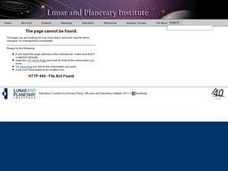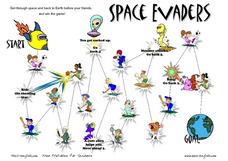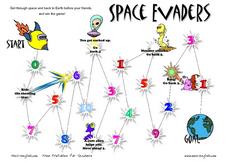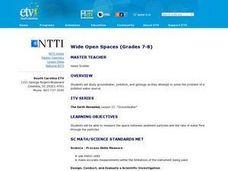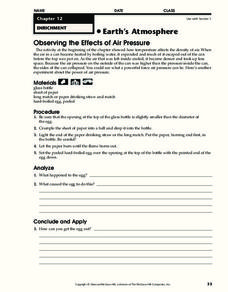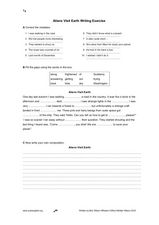Curated OER
Structure of the Earth
Sixth graders define atmosphere and hydrosphere, explore through experimentation how the atmosphere was formed, and describe the layers of the Earth's atmosphere and their distances.
Curated OER
Space Science: A Scoop of Moon Dirt
Students discover soil characteristics and how it is formed on Earth and the Moon by examining local samples to a lunar simulant. They replicate the effects of wind erosion by scraping dry bread with sandpaper. Students use rocks and...
Curated OER
Lifting Bodies: Designing Your Own Spacecraft
Students work cooperatively with classmates to design a wingless vehicle that can fly back to Earth from space, landing like an aircraft. Students plan and describe their models. Also, they will research facts about the lifting body...
Curated OER
The Flat Earth
Students differentiate between different planes. In this geometry lesson plan, students differentiate between a plane and a sphere. They discuss the Great Circle, Geodesic and Lune as it relates to the earth.
Curated OER
Space Evaders: Feelings
In this feelings-related words game worksheet, learners choose 1 of 2 game boards to play this game in which the object is to the first to make it to Earth. One game board features pictures while the other board features words that the...
Curated OER
Space Evaders: Sports
In this sports-related words game worksheet, students choose 1 of 2 game boards to play this game in which the object is to the first to make it to Earth. One game board features pictures while the other board features words that the...
Curated OER
Space Evaders: Numbers
In this number-related words game activity, students choose 1 of 2 game boards to play this game in which the object is to the first to make it to Earth. One game board features pictures while the other board features words that the...
Curated OER
Write a Space Poem
Learners write a variety of space travel poems that will be used to compile a class book and draw their own rocket and half fill it with words associated with space travel and add design and color.
Curated OER
Space Evaders
In this English Language adjective worksheet, students complete the space maze by listing the adjectives and their opposites for each picture in the maze.
Curated OER
Beyond The Earth Part I
Students explore the solar system. In this space science lesson plan, students take notes on the solar system provided by their instructors. Students then collaborate to design a computer-generated drawing of the solar system.
Curated OER
A Model of Earth's Atmosphere
Students make a model of the four layers of Earth's atmosphere that represents the characteristics of each layer.
Curated OER
Historic Earth Science Innovations
Young scholars research the demands or limitations on Earth scientists. In groups, they design and build a model that would be useful to them in the lab or field. They share their model and their ideas behind it to the class and answer...
Curated OER
Our Ever Changing Earth
First graders discover plate tectonics. They observe the forces of erosion. They observe the forces of weathering. They state three ways the earth changes. They record observations and make conclusions about their observations.
Curated OER
Space Science: Constellations and the Sun
Young scholars review the zodiac signs and illustrate their movement using constellations on the wall and themselves to represent earth. Individually or in groups, they stand in the center of the room while a shadeless lamp is placed...
Curated OER
Planet Earth
In this Earth worksheet, students review the characteristics of the Earth including it's rotation and revolution. This worksheet has 9 fill in the blank and 7 short answer questions.
Curated OER
Universal Proportions: Earth and Moon
Students create scale models of Earth, the Moon, and the distances within the universe. Working in groups, they construct their models of Earth and the Moon on a scale of 50:1 and calculate how far apart to place their models. They...
Curated OER
Radiation From Space
In this space worksheet, students will review different aspects of light, sound, and radio waves in space and the use of different types of telescopes. This worksheet has 17 fill in the blank statements.
Curated OER
Wide Open Spaces
Students examine the problem of groundwater pollution. In groups, they develop a solution to solve the problem of a local polluted water source. They also practice measuring the space between sediment particles and the rate of water flow.
Curated OER
Forces Inside Earth
For this Earth's forces worksheet, students will review vocabulary words associated with plate tectonics. This worksheet has 8 fill in the blank questions.
Curated OER
How Does Flowing Water Shape a Planet's Surface?
Students investigate how flowing water influence landforms. In this earth science lesson, students observe water behavior as it flows from the stream table at various inclinations. They discuss whether water shaped Mars landforms or not.
Curated OER
Working in Space
Students design and build one of three engineering problems dealing with living and working in space.
Curated OER
Earth's Atmosphere
In this Earth's atmosphere learning exercise, students observe the effects of air pressure using an egg. They describe what happens to the egg and what makes it do what it does. Then they determine how to get the egg out of the bottle...
Curated OER
The 9 Planets
In this space science instructional activity, students study the pictures of the nine planets. Students memorize the planets by the pictures of the planets.
Curated OER
Aliens Visit Earth Writing Exercise
In this grammar and writing worksheet, students correct the errors in 10 sentences about aliens visiting Earth. Students use 12 words in a box to complete a story and then write their own story about aliens.
Other popular searches
- Earth Space Science
- Earth and Space
- Earth in Space
- +Earth and Space Science
- Earth Space Science Quiz
- Earth Movement in Space
- Inquiry Earth Space Science
- Earth Rotation Space
- Space and Earth Science
- Earth Space
- Seeing Earth From Space
- Earth and Space Sciences

